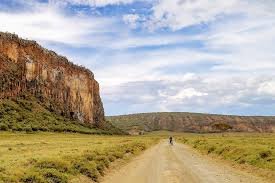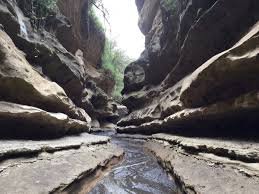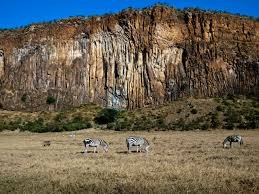Hell’s Gate National Park is a national park situated near Lake Naivasha in Kenya. The park is named after a narrow break in the cliffs, once a tributary of a prehistoric lake that fed early humans in the Rift Valley. It was established in 1984. The park is notable for its wide variety of wildlife and for its scenery. This includes the Fischer’s Tower and Central Tower columns and Hell’s Gate Gorge. The national park is also home to five geothermal power stations at Olkaria. The park features three basic campsites and includes a Maasai Cultural Center, providing education about Maasai culture and traditions.
The park itself was established back in 1984 and named ‘Hell’s Gate’ due to powerful forces shaping the national park from below. Hell’s Gate National Park is named after a narrow break in the cliffs, once a tributary of a prehistoric lake that fed early humans in the Rift Valley. It received the name “Hell’s Gate” by explorers Fisher and Thomson in 1883.
In the early 1900s, Mount Longonot erupted, and ash can still be felt around Hell’s Gate.

Hell’s Gate covers an area of 68.25 square kilometres (26 sq. miles). The park is at 1,900 metres (6,200 ft) above sea level and within Nakuru County, near Lake Naivasha and approximately 90 kilometres (56 miles) from Nairobi. The park is located 14 kilometres (9 miles) after the turnoff from the old Nairobi-Naivasha highway, and has a warm and dry climate. Olkaria and Hobley’s, two extinct volcanoes located in the park, can be seen as well as obsidian forms from the cool molten lava. Within Hell’s Gate is the Hells Gate Gorge, lined with red cliffs which contain two volcanic plugs: Fischer’s Tower and Central Tower. Off of Central Tower is a smaller gorge which extends to the south, with a path that descends into hot springs that have rocks hot enough to cause burns, and sulfuric water.
Wildlife in the national park includes lions, leopards, and cheetahs. However, the park has historically been an important home for the rare lammergeyer vultures. There are over 103 species of birds in the park, including vultures, Verreaux’s eagles, augur buzzard, and swifts. Hyraxes, African buffalo, zebra, eland, hartebeest, Thomson’s gazelle, hyena, and baboons are also common. The park is also home to serval and small numbers of klipspringer antelope and Chanler’s mountain reedbuck.
The park is popular due to its close proximity to Nairobi and lowered park fees compared to other National Parks. Hiking, bicycling, motorcycling and even camping is encouraged within the park, one of only two Kenyan national parks where this is allowed. Various Media organizations have praised the mountain climbing in Hell’s Gate as “thrilling.” It also recommended the Joy Adamson’s Centre and boating on Lake Naivasha. A Maasai Cultural Center provides education about the Maasai tribe’s culture and traditions.
The park is equipped with three basic campsites, camping is safe in the park even though there are no guns or fencing between you and wildlife. There are also several lodges around Naivasha Lake, popular among tourists for watersports, bird and game viewing in private ranches and walks along Crescent Island, Crater Lake, and Mountain Longonot.
Dramatic volcanic rocky outcrops, obsidian caves, spitting geysers, rock towers, sandstone cliffs, and water gouged gorges are what make this park worth visiting.
So, whenever you are in Kenya make it a point of duty to visit the Hell’s Gate in Kenya and enjoy the peace and pleasure of nature.





